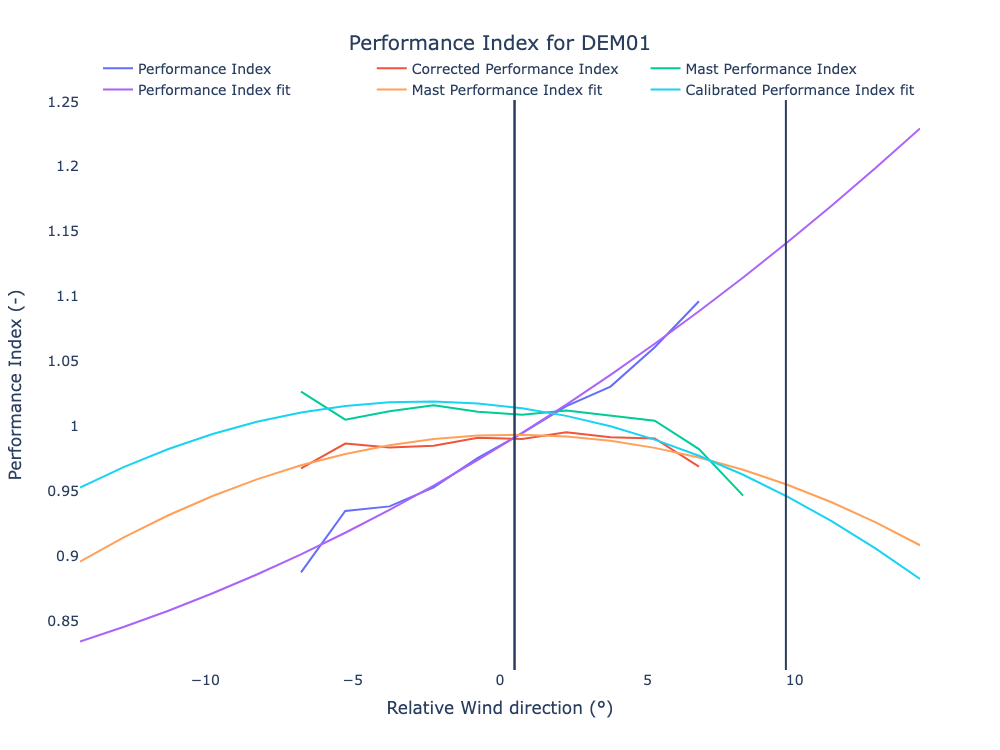Use case: Yaw misalignment method validation using met mast data
Turbine model: Siemens Gamesa SG114-2.1MW
As presented in a previous article, yaw misalignments in wind turbines can significantly impact their operation and performance. When turbines are not properly aligned with the prevailing wind direction, substantial energy losses can occur, reducing the overall performance and increasing mechanical strain on key components. Despite its importance, accurately measuring yaw misalignment is one of the most challenging aspects of wind turbine analysis: wind measurements behind the rotor makes the information of both intensity and direction to be uncertain regardless of the transfer functions applied by the manufacturer.
Over the last few years, diagnosing yaw misalignment by detecting the “best performing relative wind direction”, instead of the prevailing wind direction, has increased in popularity as it removes the need to measure the absolute relative wind direction and can improve performance by taking into account the fact that most turbines do not perform at their best when perfectly aligned with wind.
This approach presents, nonetheless, a major drawback: in order to know the best performing relative wind direction, we need to compare performance at different relative wind directions and this is where things get complicated! The rotor’s influence on wind speed depends on the relative wind direction which makes a comparison between performances almost impossible.
We at ExpertWind fully took on this challenge and developed a diagnosis method that corrects the SCADA wind speeds not only on their average value but also on the relative wind direction dependency. This use case presents one of the multiple validations we performed on this method, in this case against a reference met mast.
With this work, we wanted to validate 2 aspects of our method: ExpertWind’s wind speed correction function and the final yaw misalignment diagnosis. After applying the state-of-the-art met mast data processing and SCADA synchronisation, both the absolute wind speed error and yaw misalignment results were calculated over a period of 4 years using the SCADA and met mast measurements: in Fig.1 we present the absolute directional wind speed error, in Fig.2 ExpertWind’s wind speed correction function and in Fig.3 we compare the yaw misalignment assessments based on non-corrected SCADA data, ExpertWind’s method and met mast data.
Fig. 1 - Absolute directional wind speed error from met mast data. On average, SCADA data is underestimating the wind speed by 0.6m/s but a clear directional dependency is visible: for the negative wind directions the error can be of up to 1.1 m/s while the more positive wind directions present almost no absolute error.
Fig. 2 - ExpertWind’s wind speed correction function. A clear directional dependency is visible: the negative wind directions present a negative wind speed factor while the positive wind directions present a positive wind speed factor. This behaviour is true for all wind speeds. ExpertWind’s correction function presents the same trend and relative values as the met mast directional wind speed error.
The wind speed error shows a strong impact of the relative wind direction on the SCADA wind speed measurements. This relationship is fully detected by ExpertWind’s method that should provide more reliable (relative) corrected wind speed values for yaw misalignment assessment.
Fig. 3 - Comparison of the Performance Index vs Relative wind direction for SCADA data (blue and purple), ExpertWind’s method (red and orange) and Met mast data (green and cyan). SCADA data is not reliable for yaw misalignment, ExpertWind’s and Met mast present the exact same trend and diagnosis.
In the yaw misalignment diagnosis results, based on the detection of the best performing relative wind direction (Fig. 3), one can see that the non-corrected SCADA data completely misses the objective: the wind speed dependency on the wind direction makes the turbine appear to perform significantly better for the positive relative wind directions (symptom of a yaw misalignment) while it is clear from the mast data that no yaw misalignment is present. On the other hand, ExpertWind’s method not only corrects this issue but also presents a final result with exactly the same behaviour as the met mast analysis.
This use case highlights the added value of correcting wind speed values in an example where standard methods would have led to completely wrong outcomes. Our method addresses the most significant limitations of SCADA data for yaw misalignment detection and provides an accurate and scalable approach to monitor and optimise operating wind farms.
Want to learn more about our Yaw Misalignment diagnosis? Feel free to Contact Us for a demo of our solutions and see how your wind farms could benefit from them.



